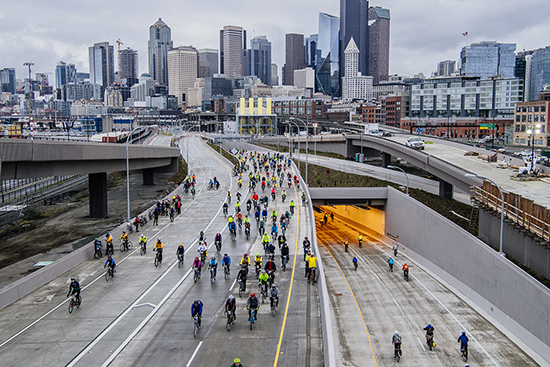|
Subscribe / Renew |
|
|
Contact Us |
|
| ► Subscribe to our Free Weekly Newsletter | |
| home | Welcome, sign in or click here to subscribe. | login |
Construction
| |
 |
September 27, 2019
GRAND AWARD
Infrastructure (transportation)
Alaskan Way Viaduct replacement/SR 99 tunnel
Location: Seattle
Owner/developer: Washington State Department of Transportation
Team: Seattle Tunnel Partners, general and concrete contractor; HNTB Corp., architect and structural engineer; CalPortland, ready-mix supplier
The Alaskan Way Viaduct replacement program known as the state Route 99 tunnel is the largest soft-ground bored tunnel in North America.
The 2-mile state Route 99 tunnel, with a 57.5-foot excavated diameter, replaced the aging Alaskan Way Viaduct as a critical part of one of the largest infrastructure projects in the United States.
Inside the tunnel, which winds under downtown Seattle, stacked 32-foot-wide roadways carry two southbound lanes atop two northbound lanes. The tunnel features state-of-the-art fire detection, fire suppression and ventilation systems and a security system with closed-circuit TVs.
After the magnitude 6.8 Nisqually earthquake in 2001, the Alaskan Way Viaduct revealed its vulnerability to seismic damage. As a result, the new SR 99 tunnel is designed to withstand roughly a magnitude 9.0 seismic event off the coast of Washington state.
To help optimize the tunnel’s durability and longevity, concrete was the primary material used throughout the project. Many forms of concrete were used, including precast tunnel segments for the tunnel liner, precast panels for the northbound roadway decks, precast bridge girders at the north cut-and-cover structure, and cast-in-place concrete for drilled shafts and roadway structures.
A total of 220,000 cubic yards of cast-in-place concrete were delivered and placed on the project. That quantity of concrete placed under the logistical constraints of working underground, under a tight schedule and with high quality expectations is a true triumph.
The tunnel was carefully carved under 157 buildings in Seattle's core by a tunnel boring machine nicknamed Bertha. Normally, tunnel roadway construction would start after tunnel excavation. In the case of SR 99, construction of the southbound roadway was done concurrently, starting approximately 500 feet behind the tunnel boring machine, sequenced to keep both tunnel construction and road construction operations in sync.
Part of this sequence included the planning and execution of the tunnel roadway concrete pours. A custom-designed traveler form system was developed to construct the roadway walls and upper deck inside the tunnel, allowing the team to meet the aggressive construction schedule for all forming operations and concrete pours, while also considering factors including the winding tunnel route, lateral inclinations of the slab and accommodating doorway, plenum and other custom block-outs.
Producing and placing that much concrete also required the coordination of equipment and activities, which kept overall emissions below the applicable threshold. Mixer trucks were retrofitted with equipment to reduce emissions. Given the sheer size of the tunnel, as well as myriad applications of concrete inside the structure (including supporting walls and roadways), nearly 100 variations of concrete mix designs were used throughout the project.
As a result of detailed planning and continual communication among personnel, all pours were completed as scheduled.
Key metrics regarding SR 99 tunnel concrete elements were 220,000 cubic yards of cast-in-place concrete; 130,000 cubic yards of structural foundations, roadways, walls and decks inside the portals, tunnel and buildings; 90,000 cubic yards of shoring piles, excavation support and temporary structures; more than 1,500 secant piles; and 14,266 concrete precast segments, 2 feet in diameter, 6.5 feet wide and 18.2 feet radial length, composing the 9,273 feet of tunnel.
Other Stories:
- Low-rise structures
- Low-rise structures (tilt up)
- Mid-rise structures (nonresidential)
- High-rise structures
- Infrastructure (non-transportation)
- Concrete paving
- Architectural and artistic
- Sustainable and resilient



